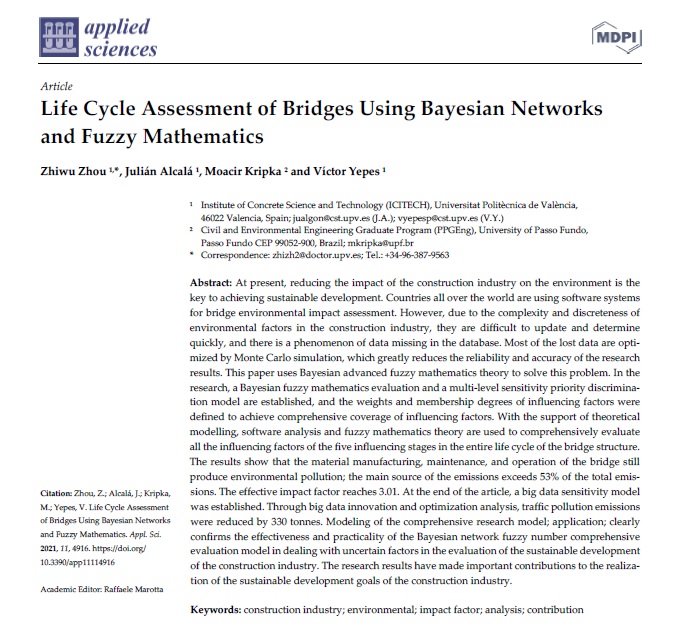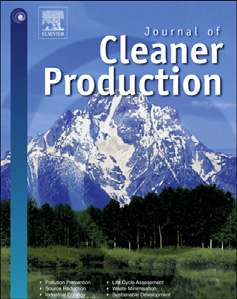 Acaban de publicarnos un artículo en la revista científica Applied Sciences (indexada en el JCR, Q2) un artículo que trata sobre el análisis del ciclo de vida de puentes usando redes bayesianas y matemática difusa. El trabajo se enmarca dentro del proyecto de investigación DIMALIFE que dirijo como investigador principal en la Universitat Politècnica de València.
Acaban de publicarnos un artículo en la revista científica Applied Sciences (indexada en el JCR, Q2) un artículo que trata sobre el análisis del ciclo de vida de puentes usando redes bayesianas y matemática difusa. El trabajo se enmarca dentro del proyecto de investigación DIMALIFE que dirijo como investigador principal en la Universitat Politècnica de València.
En la actualidad, reducir el impacto de la industria de la construcción en el medio ambiente es la clave para lograr un desarrollo sostenible. Son muchos los que utilizan software para evaluar el impacto ambiental de los puentes. Sin embargo, debido a la complejidad y discreción de los factores medioambientales de la industria de la construcción, es difícil actualizarlos y determinarlos rápidamente, y se da el fenómeno de la pérdida de datos en las bases de datos. La mayoría de los datos perdidos se optimizan mediante la simulación de Monte Carlo, lo que reduce en gran medida la fiabilidad y precisión de los resultados de la investigación. Este trabajo utiliza la teoría matemática difusa avanzada bayesiana para resolver este problema. En la investigación, se establece una evaluación de matemática difusa bayesiana y un modelo de discriminación prioritaria de sensibilidad de varios niveles, y se definen los pesos y los grados de pertenencia de los factores de influencia para lograr una cobertura completa de los factores de influencia. Con el apoyo de la modelización teórica, se evalúan exhaustivamente todos los factores de influencia de las etapas del ciclo de vida de la estructura del puente. Los resultados muestran que la fabricación de materiales, el mantenimiento y el funcionamiento del puente siguen produciendo contaminación ambiental; la fuente principal de las emisiones supera el 53% del total de las emisiones. El factor de impacto efectivo alcanza el 3,01. Al final del artículo, se estableció un modelo de sensibilidad de “big data“. Optimizando con estas técnicas, las emisiones contaminantes del tráfico se redujeron en 330 toneladas. Se confirma la eficacia y la practicidad del modelo de evaluación integral de la metodología propuesta para tratar los factores inciertos en la evaluación del desarrollo sostenible en el caso de los puentes. Los resultados de la investigación contribuye a alcanzar los objetivos de desarrollo sostenible en la industria de la construcción.
El artículo se ha publicado en abierto, y se puede descargar en el siguiente enlace: https://www.mdpi.com/2076-3417/11/11/4916
ABSTRACT:
At present, reducing the impact of the construction industry on the environment is the key to achieving sustainable development. Countries all over the world are using software systems for bridge environmental impact assessment. However, due to the complexity and discreteness of environmental factors in the construction industry, they are difficult to update and determine quickly, and there is a phenomenon of data missing in the database. Most of the lost data are optimized by Monte Carlo simulation, which greatly reduces the reliability and accuracy of the research results. This paper uses Bayesian advanced fuzzy mathematics theory to solve this problem. In the research, a Bayesian fuzzy mathematics evaluation and a multi-level sensitivity priority discrimination model are established, and the weights and membership degrees of influencing factors were defined to achieve comprehensive coverage of influencing factors. With the support of theoretical modelling, software analysis and fuzzy mathematics theory are used to comprehensively evaluate all the influencing factors of the five influencing stages in the entire life cycle of the bridge structure. The results show that the material manufacturing, maintenance, and operation of the bridge still produce environmental pollution; the main source of the emissions exceeds 53% of the total emissions. The effective impact factor reaches 3.01. At the end of the article, a big data sensitivity model was established. Through big data innovation and optimization analysis, traffic pollution emissions were reduced by 330 tonnes. Modeling of the comprehensive research model; application; clearly confirms the effectiveness and practicality of the Bayesian network fuzzy number comprehensive evaluation model in dealing with uncertain factors in the evaluation of the sustainable development of the construction industry. The research results have made important contributions to the realization of the sustainable development goals of the construction industry.
Keywords:
Construction industry; environmental; impact factor; analysis; contribution
Reference:
ZHOU, Z.; ALCALÁ, J.; KRIPKA, M.; YEPES, V. (2021). Life cycle assessment of bridges using Bayesian Networks and Fuzzy Mathematics. Applied Sciences, 11(11):4916. DOI:10.3390/app11114916

